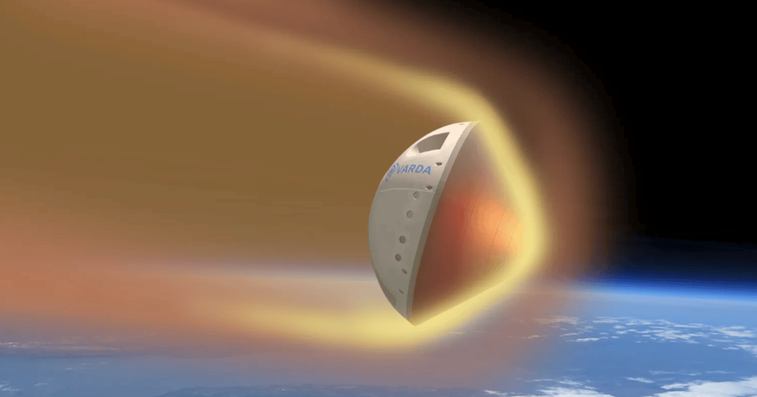
In the cold, windswept desert of Western Utah, history was just made.
At 1:40 PM Pacific time yesterday, a small spacecraft landed in the desert in the Utah Test and Training Range, controlled by the U.S. Department of Defense.
It had just spent eight months in Earth's orbit.

Visibly charred from the heat of re-entry into Earth’s atmosphere, its half-spherical shape, not even waist high, doesn’t evoke images of a typical spacecraft.
It’s more likely to remind us of a buoy in a dry lakebed.

But it is so much more than that.
In fact, it’s the beginning of an entirely new industry.
The above spacecraft is actually a small factory designed to manufacture products in space and return them to Earth.
The above spacecraft, W-1, is a prototype for what will ultimately become large scale production in space.
It’s a proof of concept to show that a small “factory” can be launched into low Earth orbit (LEO) with raw materials, manufacture a desired product or compound, and return its finished payload back to Earth.
And it appears that it worked.
The company behind this breakthrough is Varda Space Industries, a small early stage aerospace company with an incredible vision.
Varda launched W-1 back in June of last year… as a payload on a SpaceX Falcon 9 rocket.
The first payload for Varda was the drug Ritonavir, which was heated and cooled repeatedly in space in order to study the effects of microgravity on how particles crystalize. Simply doing so can improve the quality and stability of the drug.
Pretty incredible… but this isn’t a new concept.
Back in 2019, Merck had performed experiments on the International Space Station with its cancer drug Keytruda.
Merck found that manufacturing the key compound in Keytruda resulted in a more stable crystalline structure… which, if manufactured in space, could extend the shelf life of the drug, and improve patient outcomes.
The results are visually obvious.
Take, for example, the images below. On the left, is an ultraviolet image of the key compound of Keytruda manufactured on Earth.
On the right is the same compound… manufactured in microgravity on the International Space Station.
The results are radically different.

Manufacturing in microgravity results in a more uniform particle size.
In other words, manufacturing in the absence of the force of Earth’s gravity allows particles to crystalize with far fewer “defects.” It’s like removing “stress” from the manufacturing process.
Microgravity improves the purity of particle crystallization, which is not only relevant to improving the purity of medicines, but also relevant to eliminating defects in something like a fiber optic cable.
If we think about medicines, microgravity can result in compounds that can be delivered orally instead of intravenous. More stable compounds enable different delivery mechanisms.
It can also improve bioavailability and solubility of a medicine, improving patient outcomes, reducing side effects, and even extending the shelf life.
The reality is that many chemical compounds benefit from microgravity manufacturing, due to the way they crystalize.
So it’s no surprise that biotech and pharmaceutical companies are attracted to this kind of manufacturing. Increased shelf-life due to more stable compounds result in cheaper distribution levels and less wastage due to a short expiration date.
Other areas that are highly suitable for microgravity manufacturing are semiconductors and fiber optics. Manufacturing in microgravity will even make the manufacturing of certain products possible — products that can’t be manufactured under the stress of Earth’s gravity.
I know this all might sound crazy.
I’m sure many of us are thinking that it is way too expensive to put a factory in space and then “ship” the products back to Earth. The final product cost would be too high, right?
Wrong.
Today’s cost per kilogram on a SpaceX Falcon Heavy is just $1,400.
That’s already a price point that makes high-value product manufacturing in low-Earth orbit attractive.
But that’s not what has me excited.
Once SpaceX is flying regular flights to orbit with its Starship, which won’t be too far away, launch costs per kilogram will drop to around $90-100.
SpaceX is preparing for its third test flight of the Starship right now, which is expected to rocket to orbit within the next three weeks.

Costs at these levels will democratize access to space.
This is the single most important enabler and accelerant to the private space economy.
At prices this low, even small early stage companies will be able to afford launching their products into orbit.
This is the key to space manufacturing. Varda’s timing is not accidental.
Founded in 2020, it knew where launch costs were going. In less than 2 years, the team at Varda developed a spacecraft and re-entry vehicle.
The motivations are obvious. Varda, as a first mover in developing completely independent, self-operating manufacturing spacecraft, can have its low-Earth orbit (LEO) factories ready for launch when Starship begins its commercial launches to orbit. It will dominate the market.
Just imagine a “field” of Varda’s space “factories” in orbit producing a variety of products and returning them to Earth. Launch, manufacture, re-entry… wash, rinse, repeat.
It won’t be long before we receive a package with a small label marked:
“Made in Space”
Welcome to the Outer Limits! If you're just joining us for the first time, we encourage you to visit our FAQ, which you can access right here.
If you have any questions, comments, or feedback, we always welcome them. We read every email and address the most common threads in the Friday AMA. Please write to us here.
